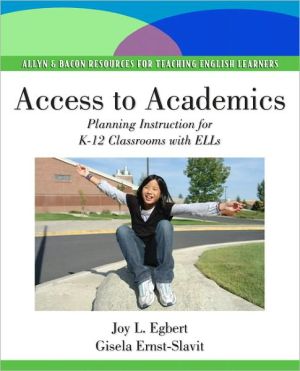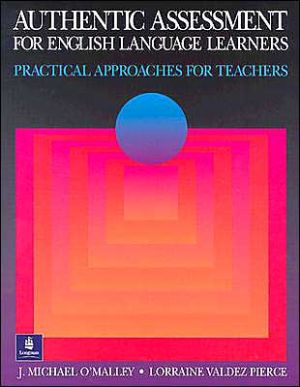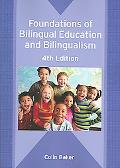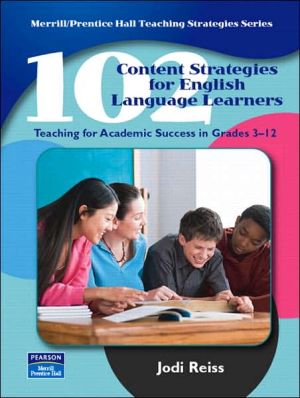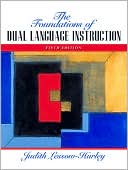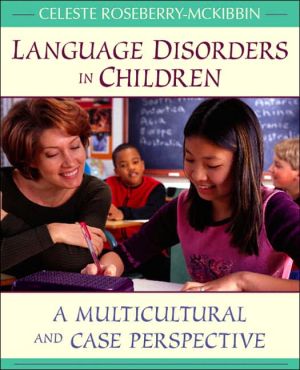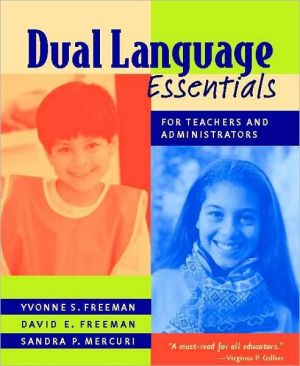Access to Academics: Planning Instruction for K-12 Classrooms with ELLs
DRAFT\ Joy L. Egbert and Gisela Ernst-Slavit\ Access to Academics:\ Planning Instruction for K-12 Classrooms with ELLs\ \ Written specifically for K-12 pre-service and in-service content area teachers who work with ELLs, this book recognizes that teachers are the ultimate decision-makers when it comes to instruction and is geared towards helping teachers think about issues in ways that they may not have previously considered.\ Access to Academics: Planning Instruction for K-12 Classrooms...
Search in google:
Joy L. Egbert and Gisela Ernst-SlavitAccess to Academics:Planning Instruction for K-12 Classrooms with ELLsWritten specifically for K-12 pre-service and in-service content area teachers who work with ELLs, this book recognizes that teachers are the ultimate decision-makers when it comes to instruction and is geared towards helping teachers think about issues in ways that they may not have previously considered.Access to Academics: Planning Instruction for K-12 Classrooms with ELLs takes a different approach to language–addressing it as a tool students must use constantly, in a variety of school venues and in different ways depending on the context. The book shows language as vital to content access and thereby academic achievement, but, more importantly, it also provides step-by-step instructions explaining how to help students acquire the language they need. Although the main emphasis is on English language learners (ELLs), the term “diverse learners” used throughout also encompasses the great variety in any classroom of student backgrounds, abilities, needs, and interests."This book carefully outlines exactly what the classroom teacher needs to do in order to correctly accommodate ELL students in the content area classroom."- Kimberley Kreicker, Ph.D., Emporia State University, Lawrence, KansasJoy Egbert, PhD, is Professor of ESL and Education Technology at Washington State University, Pullman. She is an award winning teacher, materials developer, and researcher. She is the author of Supporting Learning with Technology: Essentials of Classroom Practice (Pearson, 2009), CALL Essentials (TESOL, Inc, 2005), and seven other books for ESL and technology-using teachers, in addition to many other publications.Dr. Gisela Ernst-Slavit is a professor at Washington State University Vancouver. She investigates language and education in culturally and linguistically diverse settings using ethnographic and sociolinguistic perspectives. She teaches courses in ESL methods, sociolinguistics, research on second language teaching and learning, and critical issues for Latino students.
PART ONE – Understanding the Roles of Language and ContentChapter 1 – Academic success: Learning the language of school Key Issues Cartoon – ELLs need to learn much more than just language The language of school Social language Everyday aspects Example of concept: What’s in a name? Intercultural aspects Instructional aspects Academic language Vocabulary Grammar/Syntax Discourse The BICS/CALP distinction Connection between BICS/CALP and the language of school Extensions For Reflection For ActionChapter 2 – The role of language proficiency in school Key Issues Language proficiency Language domains Receptive and productive skills Factors influencing language proficiency Levels of language proficiency Starting Emerging Developing Expanding Bridging The role of native languages and cultures Connection between academic language and content Language functions Academic achievement Communicative competence Keys for developing academic language Extensions For Reflection For ActionPART TWO – Components of Effective Lesson Design Chapter 3 – Assessing student strengths and needs Key Issues Background Understanding Needs Collecting General Information Language Background and Needs Educational/Academic Background Content Background and Knowledge Cultural Background Guidelines for Understanding Student Needs Conclusion Extensions For Reflection For ActionChapter 4 – Writing and teaching to language objectives Key Issues Background Understanding Objectives Content objectives Language objectives Teaching to language objectives Conclusion Extensions For Reflection For ActionChapter 5 – Connecting to students’ lives Key Issues Background Understanding Connections Making personal connections Making academic connections Building Background Knowledge Integrating Connections Guidelines for Making Connections Conclusion Extensions For Reflection For ActionChapter 6 –Designing Engaging Tasks Key Issues Background Understanding Engaging Tasks Elements of Tasks Elements of Task Process Instructional groupings Modes Task structure Time and pacing Scaffolding Resources/Texts Teacher/Student roles Procedural tools. Elements of Task Product Pedagogical Connections Guidelines for Task Design Conclusion Extensions For Reflection For ActionChapter 7 – Assessing Lessons and Students Key Issues Background Understanding Assessment Assessing Student Process and Product Homework and Parents Assessing Lessons Guidelines for Assessment Conclusion Extensions For Reflection For ActionPART THREE – Designing Lessons for Academic SuccessChapter 8 – Unlocking the language of Ssience Key Issues National and state standardso Emphasis on inquiry and discovery learning The role of students’ languages, cultures and communities The specialized language of scienceo Vocabularyo Grammar/Syntaxo Discourseo Language functions· Teaching strategies for learning and talking science· Talking science: An example from the classroom Extensionso For Reflectiono For ActionChapter 9 – Unlocking the language of mathematics Key Issues National and state standardso Emphasis on problem solving The role of students’ languages, cultures and communities The specialized language of mathematicso Vocabularyo Grammar/Syntaxo Discourseo Language functions· Teaching strategies for learning and talking mathematics· Talking math: An example from the classroom Extensionso For Reflectiono For ActionChapter 10 – Unlocking the language of English language arts Key Issues National and state standardso Preparing students for the literacy demands of today and tomorrow The role of students’ languages, cultures and communities Literacy and language learning: An integrated modelo Textso Processes and strategieso Systems of structure of languageo Audienceso Contexts· Teaching strategies for learning language skills and literacies· Placing the learner at the center: An example from the classroom Extensionso For Reflectiono For ActionChapter 11 – Unlocking the language of social studies· Key Issues· About the field of social studies· The specialized language of social studieso Grammatical featureso Discourse· Strategies for teaching and learning social studies· Extensionso For Reflectiono For ActionChapter 12—Putting it all together· Key Issues· Background· Understanding the whole· Lesson exampleso Adapting lessons· Guidelines for creating and adapting lessons· Extensionso For Reflectiono For ActionReferencesAppendix A Index (to be decided)
